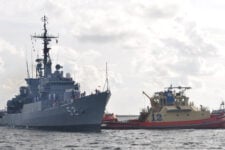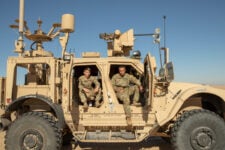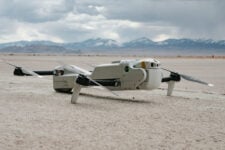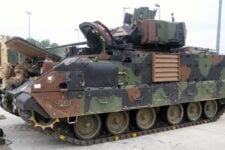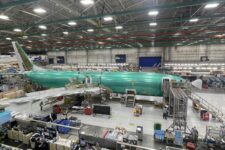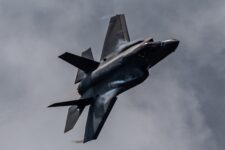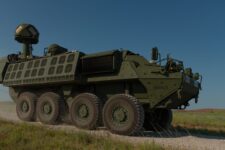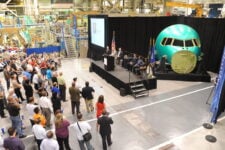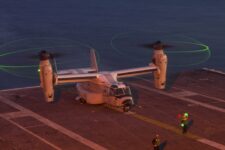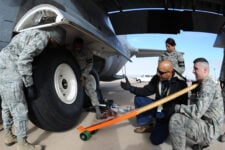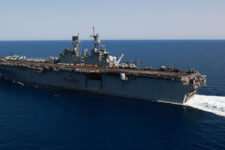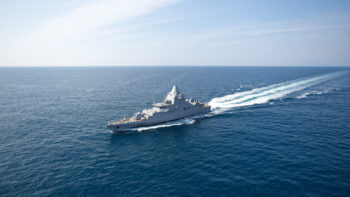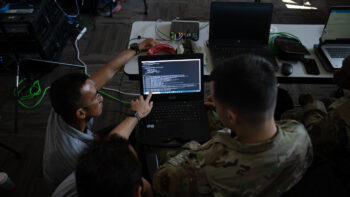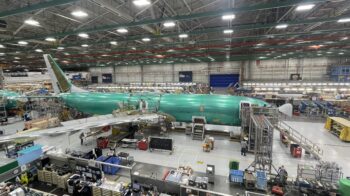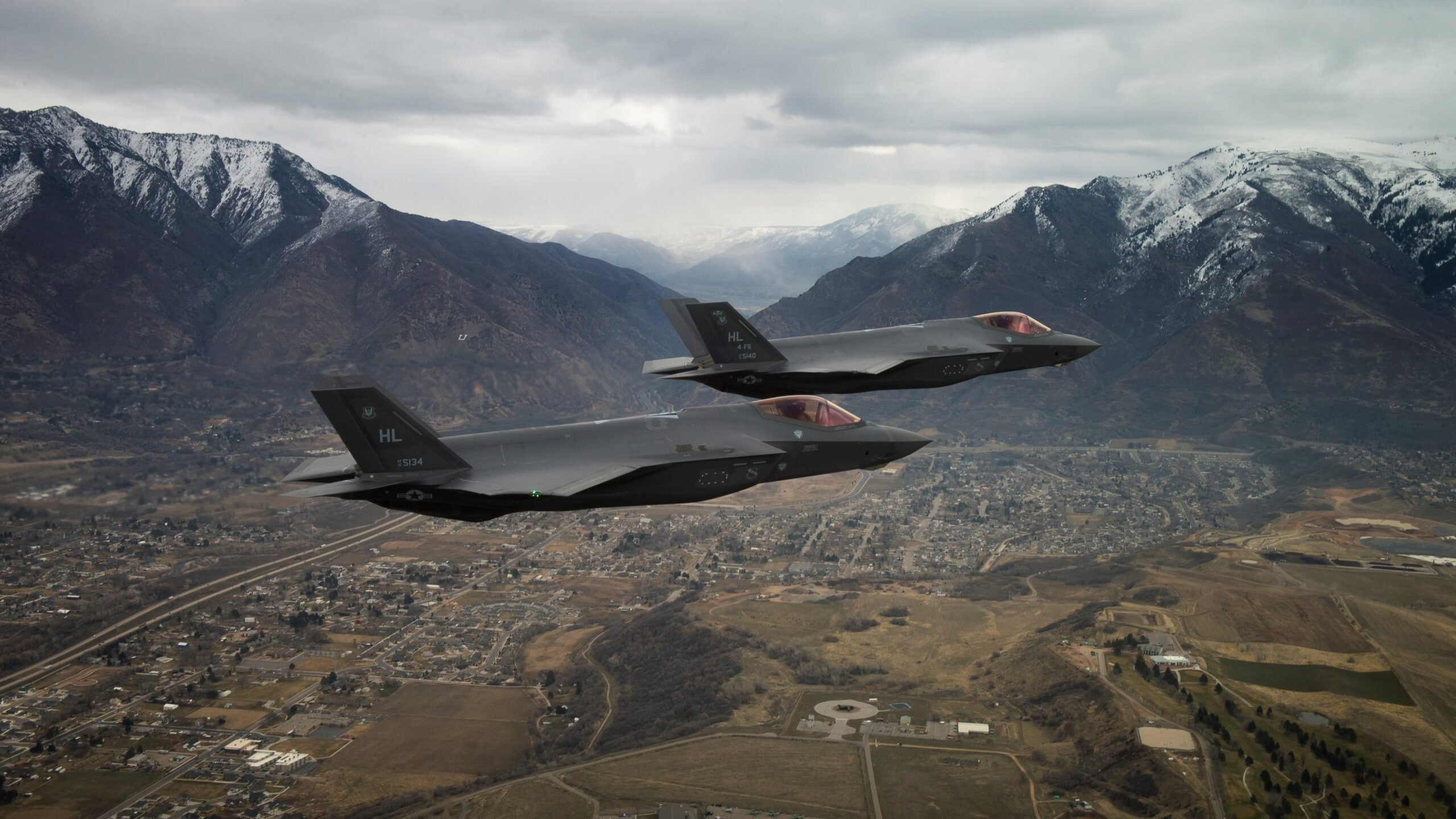
Two U.S. Air Force F-35A Lightning IIs, assigned to the 4th Fighter Squadron from Hill Air Force Base, Utah, fly over the base and the surrounding area on Feb 14, 2018. (U.S. Air Force photo by Staff Sgt. Andrew Lee)
WASHINGTON — Problems with an upgrade installed on some Lockheed Martin F-35 Joint Strike Fighters rolling off the production line have now disrupted plans to incorporate those upgrades on existing aircraft, and the F-35 Joint Program Office does not have a date for when those jets will get the much-anticipated retrofits.
The F-35 program “was scheduled to begin TR-3 [Technology Refresh 3] retrofits in April 2024 with the intent to modify 149 aircraft over the subsequent 12-month period,” JPO spokesperson Russ Goemaere told Breaking Defense. But now, “[t]he Program is working closely with F-35 customers to establish a new start date for those modifications based on a number of factors including software and supply chains.
“Very capable TR-2 jets will continue to fly operational missions while awaiting the start of TR-3 retrofits,” he said. A breakdown of how those planned retrofits are shared across the fighter’s three variants and international customer base was not immediately available.
“We must improve our efficiency in integrating and testing TR-3 and Block 4 capabilities (Hardware and Software),” Goemaere said.
Since July 2023, the Pentagon has refused to accept newly built F-35s due to software woes with the TR-3 upgrade, which has slipped numerous times past its original fielding date expected for April 2023. TR-3 is now projected to be completed sometime between July and September of this year, when Lockheed will then be able to deliver new, fully upgraded planes, according to the company. (The F-35 program is also exploring a plan to resume deliveries before TR-3 is finished, but no decision has yet been made.)
Lockheed has continued to build and deliver jets equipped with TR-2 in the meantime, and previously planned on shipping out TR-3 kits that could be swapped out with TR-2 on existing fighters starting this month. But the upgrade’s continued software woes, combined with supply chain issues constraining the production of TR-3 hardware, have now pushed back those retrofit plans to an unspecified date.
Though the JPO acknowledged there’s no specified date for the retrofits, Goemaere claimed they are “not delayed indefinitely.
“Retrofits will be deferred for a period time until TR-3 software performance improves and manufacturing rates of TR-3 hardware meets the demands of production, sustainment, and retrofits,” he said. “The F-35 program has been and continues to take steps to increase manufacturing rates with progress over recent months.”
Goemaere did tell Breaking Defense that “[d]elays in production of TR-3 parts for new aircraft builds has caused delays in production of TR-3 parts for current aircraft,” adding “recovery is expected in FY25.” Goemaere also said that “risk still remains with TR-3 delivery and production. However, the JPO and Lockheed Martin anticipate production of TR-3 hardware kits will keep pace with the delivery schedule once DD250 resumes.” DD250 refers to the government’s check out process for accepting new weapon systems.
TR-3 — which features a more powerful processor, greater memory and a panoramic cockpit display that collectively enable a suite of new capabilities known as Block 4 — has been a source of pride for Lockheed but also a headache as problems arose. The company has maintained it can still build at a rate of 156 jets per year, but only 75 to 110 new stealth fighters are expected to be delivered in 2024 as a result of the TR-3 issues.
As many as 100 to 120 jets could be awaiting delivery come the year’s end as Lockheed works to clear out its backlog once acceptances resume, executives said during the company’s January earnings call. The Pentagon has additionally been withholding $7 million in payments for each newly-built F-35 placed in storage, Bloomberg reported, which could amount to a total of over $800 million if the delivery pause stretches through June.
In December, F-35 program head Air Force Lt. Gen. Mike Schmidt warned lawmakers about TR-3 hardware shortages and pointed the finger at some supply chain issues. Challenges with getting “a couple” of unspecified TR-3 components risked impacts to both newly built jets and planned retrofits, Schmidt testified.
“The TR-3 hardware is coming up a ramp that is not where it needs to be. It is not meeting our contractual requirements,” Schmidt said. He later told reporters that industry has “a little time here to ramp up, but they need to do it quickly parts-wise.”
For its part, the Air Force has said that TR-3 issues informed the service’s decision to scale back its latest fighter buy, with the Navy and Marine Corps also cutting their F-35 spending due to budget caps imposed by Congress.
“We want the planes that we want. And the TR-3 [and] Block 4 capabilities have been delayed. So, our approach is to minimize the impact of that by procuring fewer of those in the first years of the FYDP [future years defense program],” Kristyn Jones, who is performing the duties of the service’s under secretary, told reporters in a March 11 briefing. Toward the end of the five-year FYDP spending outlook, the F-35 buy would then climb back up as more capabilities become available, she added. Following the briefing, an Air Force spokesperson confirmed to Breaking Defense that the service’s decision was influenced by “both software and hardware delays.”
The National Guard in its FY25 unfunded priority list requested money to restore the F-35 purchases that the Air Force sought to cut.
Citing the company’s quiet period ahead of an earnings call planned for later this month, Lockheed declined to answer detailed questions about TR-3 production for this report, but said “TR-3 remains our top priority and we continue to produce F-35s at rate.
“We expect to begin delivering TR-3 jets in the third quarter and are committed to providing unrivaled, advanced capabilities in support of our customers’ missions,” the company continued. “As stated in our January earnings call, the aircraft delivery range for 2024 is between 75 and 110 and requires TR-3 suppliers to keep pace with production demands, both this year and in the future. We have deployed employees to suppliers to expedite quality hardware delivery and are working to ensure the required kit production capacity infrastructure, supporting demand for new production aircraft, modification and spares.”
Air Force special ops commander tapped to lead Air Force Academy, other nominees announced
The Pentagon announced nominees for other key Air Force roles, such as a new deputy chief of staff for plans and programs.

